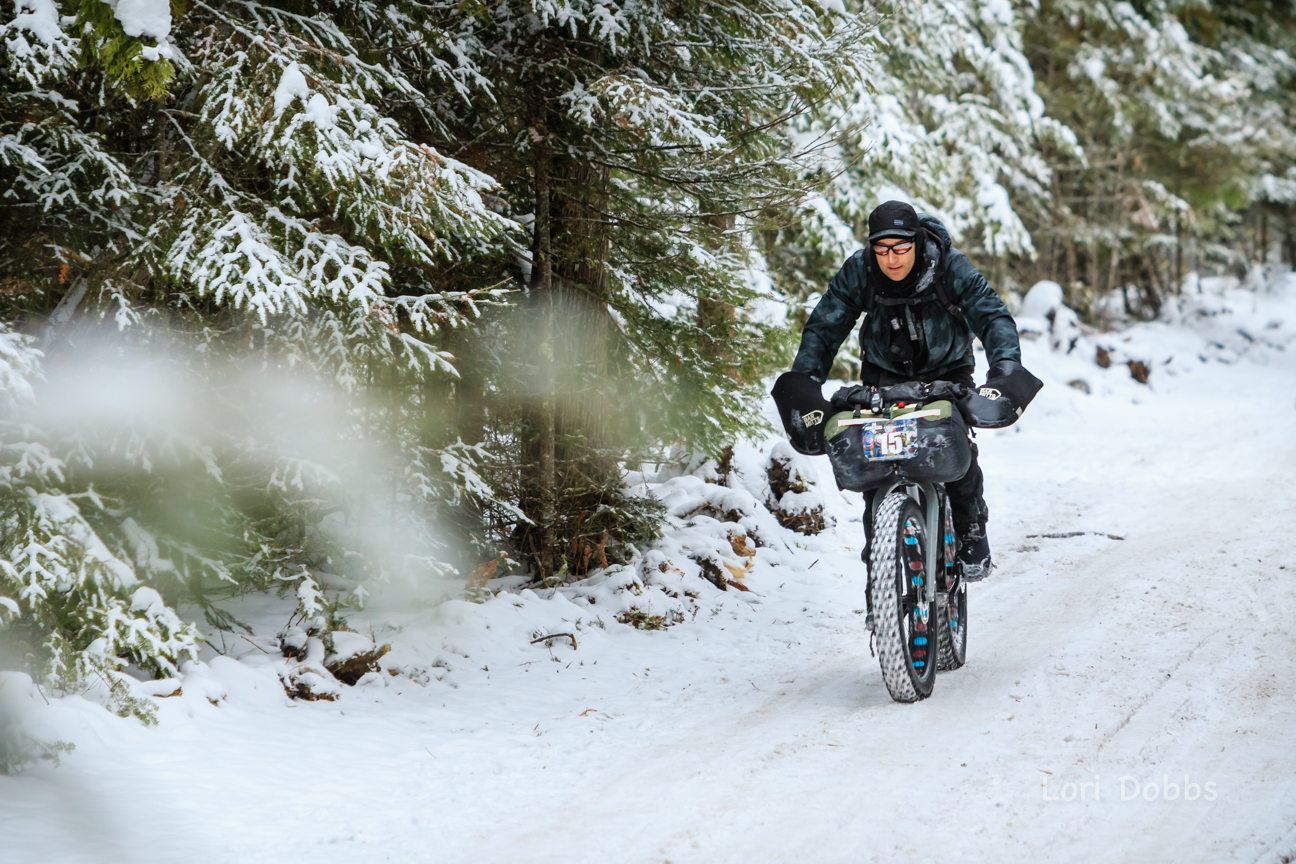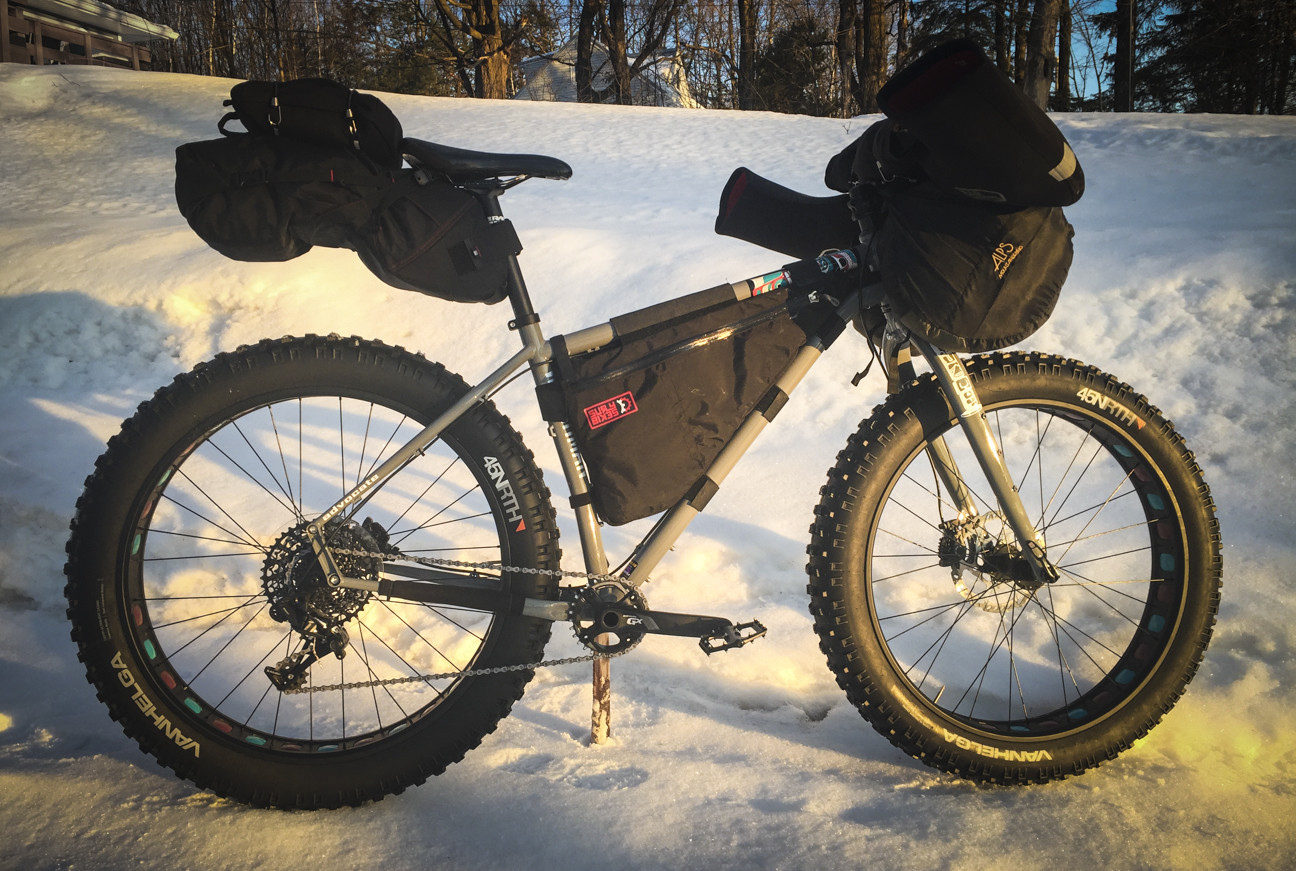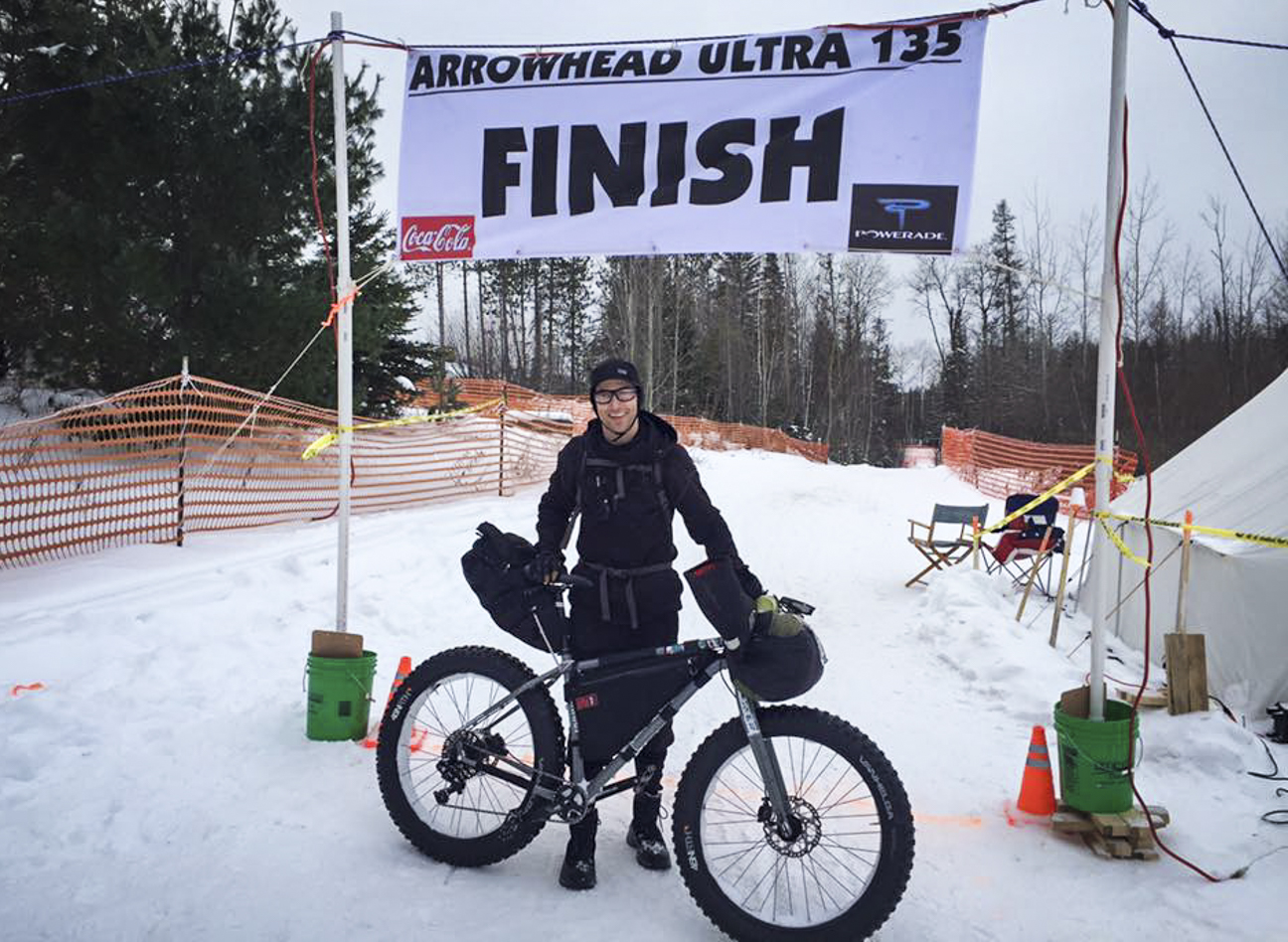
The Arrowhead Ultra 135 travels through northern Minnesota on the rugged and scenic Arrowhead State Snowmobile trail from International Falls to Tower, Minnesota. Known to be an extremely difficult race, it takes place in the coldest town in the lower 48 states and has a finish rate of less then 50%. It’s tough—throw in subzero temps or fresh snow and it becomes even tougher.
Barry Buhr just completed the 2016 Arrowhead aboard an Advocate Watchman so we caught up with him to see how the event went, how he prepared, and what he brought along on the journey. In the past, Barry has taken part in numerous distance cycling events including the Chequamegon 100, Maah Daah Hey 100, Rusty Ride 100, Duluth 100, Lutsen 99er and the Marji Gesick 100—although, none of them quite compare to the Arrowhead. Here’s what Buhrito had to say.
Preparation
Let’s start with how I trained for this event. I took a two-week snowboarding trip and didn’t ride a bike for 23 days, which was by far the longest time off a bike in years. Despite the fact that I was doing zero dedicated training, I was spending my usual amount of time outside in the snow and cold—getting a good workout everyday. I think in a way, this time off the bike was good because I’ve been developing what seems to be tendonitis in my knee, which started back in the summer, and time off the bike may have been a positive thing.
When I got home to Duluth, I had two weeks until the race. The very first day back it was -20 and I thought, “perfect, let’s get back to biking and get the cold tolerance built up.” All the miles and training had happened throughout the season, so getting my layering right and getting the gear packed solid was my main focus. In the days leading up to the big day I spent a good amount of time practicing with the gear, went on a few test rides, and felt really happy about how it all worked.
The Gear
For the event, I rode a rigid Advocate Watchman with 1×11 drivetrain and Vanhelga tires on 90mm rims. For gear hauling I made a simple sleeping bag fastener for the fork that worked great and had a Surly frame bag that held food, thermos, pump, tube and tools. On the back I had a Revelate seat bag that held the stove, fuel, sleeping pad, bivy, and extra layers. I also had an additional small bag strapped to the seat bag, which I used for more food. On the bars I had Barr Mitts, allowing me to wear summer gloves the entire time. I also brought along a Mountain Hardware 800 Down -20 sleeping bag, a Thermarest NeoAir sleeping pad, Outdoor Research bivy, Jetboil stove, fuel, and pot kit. For riding in the dark I brought along a Niterider OLED 800 light that I used in walk mode and a 100-lumen headlamp. I also carried a phone with an extra power source in case of emergency.
I decided not to use a drop bad out on the course so I carried a lot of food. Three peanut butter, honey, jalapeno, and bacon sandwiches, a big bag of trail mix, a big bag of sunflower seeds, beef jerky, two whey protein bars, four granola & nut filled bars and the customary jar of peanut butter.
For clothing, I wore what I would consider my “late October” gear most of the time. I wore thick wool socks, chamy tights with shorts over them, fleece base layer and hoody, an ultralight shell that I used about half the time, insulated hiking boots that I cut down the tread on to better mesh with my flat pedals, and a hat and balaclava.
International Falls
By the time Sunday arrived, the excitement for the event had come to life. We got to International Falls a little after noon—I wanted to have a solid amount of time for gear check incase any surprises popped up. The check-in/inspection was very smooth and I felt good about all the time I’d spent packing and re-packing to get everything dialed. After the check-in, we had to kill a few hours until we could check into our room and until the racers meeting so we drove around the town—I think we saw all the attractions.
After the rider meeting, I decided to suit up and ride from the hotel to preview a portion of the first snowmobile trail. The snow was soft as expected and definitely didn’t look like it was going to set up overnight. I rode back to town, had a few beers, and went to bed feeling confident in my tire choice given the snow conditions.
Race Day
It was warm and misty in the morning. I felt like I was dressed light, but I would later wish I was dressed lighter. I was sweaty in the first five minutes. I did pack a full extra base layer though and planned to change into that at Melgeorge’s. I figured if I kept moving at this pace I should be warm enough, albeit wet, until there.
I went out pretty fast, knowing that it would help a lot to find the “sweet spot” of where many previous riders had ridden the trail. Too far up front and I would be kind of blazing trail—after too many people and it’d be rutted. And rutted it did get—making it so you couldn’t lose focus even for a moment, or you’d catch the side of the rut and get pulled into the soft snow and come to a stop or expend a bunch of extra energy trying to save it.
It took me longer than I expected to get to the first checkpoint at Gate Store. While, I was okay with the pace, it also threw out my top time goals. I had figured that in good conditions with solid trail surface, this ride could maybe happen for me in 18-20hours and if it was soft or really cold, maybe 21-24 hours. With some additional adversity I figured 25-30 hours. Any more than that, and I figured something miserable would be happening…
With singletrack being my forte, I was riding relatively efficient though the ruts and morale was high. The hope had been to cross Elephant Lake in the daylight but alas, it was not to be. Riding by bike light now, I heard the wind before I got to the lake and knew what was coming. I thought I could make it across in my sweaty clothing but about 1/4 mile onto the open lake, the headwind got intense and the shell had to come out. As that cold wind hit my soaked body, the level of seriousness bumped up a notch.
Melgeorge’s Cabin
I finished the longest mile-long lake crossing ever with some nice folks cheering and Pam waiting at the end to offer some encouragement. She knew this was already taking me longer than I hoped. And then there it was, lit up like some sort of haunted house—Melgeorge’s cabin. I had heard what it does—it sucks you in—and so I hesitated going in. But I had brought fresh base layer and needed a place to change.
As I arrived at the cabin, TMF was outside. He offered this advice “Go in there, and get good and ready. Get dry, and don’t leave until you’re ready, even if it’s hours.” So I went in. The volunteers were nice enough to dry my clothes so that I had a full backup for emergency on the second half if needed. Two plus hours ended up being the amount of time that just felt right and it was about 10pm when I pedaled out of the driveway, with Pam cheering me on as she headed off to Fortune Bay—hoping to see me by about 11am or maybe noon. Her cheers faded and I was on my own for the night. All. Night.
Into the Night
I had left Melgeorge’s feeling good physically and mentally. By midnight though, I started to fade—my legs were still there, but my head wasn’t. I started literally falling asleep at the bars, doing that thing where you snap back to it quick. It was painful and just got overwhelming.
At about 2am I came across the Myrtle Lake shelter. There was a pair of ski’s leaning against it and someone was in their bivy. I sat there for a couple minutes, contemplating if I should do the same. Honestly, I was a little scared to camp because I was sweaty and although it was “warm” out, it was still around 20° and that’s plenty cold enough to send a wet person in hypothermia. I chose to keep on, knowing that there was supposed to be another shelter in about 12 miles if I still needed it. Seeing someone in their bivy gave me the confidence that I could hopefully do the same if needed.
After 3 more delirious hours, at 5am, I finally stumbled across the Elbow Lake shelter and I thought, “Yes, this is happening right now.” I pulled out the sleeping bag, pad, and bivy—set it all up and got right in. The best move would have probably been to strip down but I just kept my clothes on. I slept okay for 3 hours. I heard at least two others come and go during the time I half slept. Finally, when I saw it was almost 9am, I forced myself to get going again, I knew that several people had passed me and that this “race” wasn’t going to finish itself.
Back on the Trail
With setup/packing, this had taken over 4 hours now. I was freezing as soon as I got out of the bag with hands shaking while I re-packed everything. Then I looked over to the trail and a saw that a foot racer was coming by. This got me motivated to get moving and I actually covered some pretty good ground for a bit after this—eager to see that Surly checkpoint I wanted so badly to come across in the dark. It had taken me two more hours to get there and I don’t think I’d have made it there without sleep.
I met Bob at the tent and he had the most heavenly cup of coffee ever for me. They also had a bottle, which I declined at first but then opted for after the coffee. This quick pit stop was great for morale.
Soon after that I was at Wakemup hill, the most notorious of all hills on the course. It’s huge when you’re pushing a 50+lb-loaded beast through a few inches of fresh snow. I crested the hill and there it was—something nobody ever mentions—what I will forever refer to as the Wakemup Hilltop Halfpipe. It was a ditch with fresh snow. Everyone had ridden right down the middle. I surfed it. It was awesome.
Unfortunately, after that, the terrain got pretty flat. Flat should be easy, but it was back to long straightaways that went by painfully slow. I’d be going down these long straightaways but moving so slow because it was just like walking a tightrope. Then, when finally at the end of the straightaway, it’d just take a slight bend into another one, which was mentally tiring.
Coming to an End
At some point, I checked my phone and had a signal. I saw where I was on the map and that helped a little. And then finally, I rounded the corner and saw the uphill to the finish. Pam and a few others were there waiting and so I got out of the saddle for one last hammer. I crossed at 3:56pm, for a time of 32hrs56min. I was a tad bummed I had to stop and lost a lot of spots but otherwise, I felt pretty good—my brain having benefited greatly from the few hours of rest. The volunteers were so nice and the guy at the finish kindly guided me inside for the post-race inspection. I collected my awesome trophy, hot-tubbed, hit the buffet, and passed out.
Thanks to everyone who lent me gear—it felt good to actually use all the things I carried! I’m glad that it turned out to be a uniquely difficult Arrowhead and I’ll be sending in my 2017 application come September.
Arrowhead Tips
For anyone considering riding the Arrowhead 135 I would recommend getting out and riding your bike in conditions that make you uncomfortable. Remember what layers you wear for every temperature range because the event and location can throw anything at you. Practice riding with your gear loaded on your bike and know how to use each piece of gear—try to use the bivy for at least a couple hours in the cold to see what it’s like. Go on long rides and just work on breathing and relaxing when it gets torturous. And remember that the coldest, most brutal bike ride is almost always still better than most days at work.

